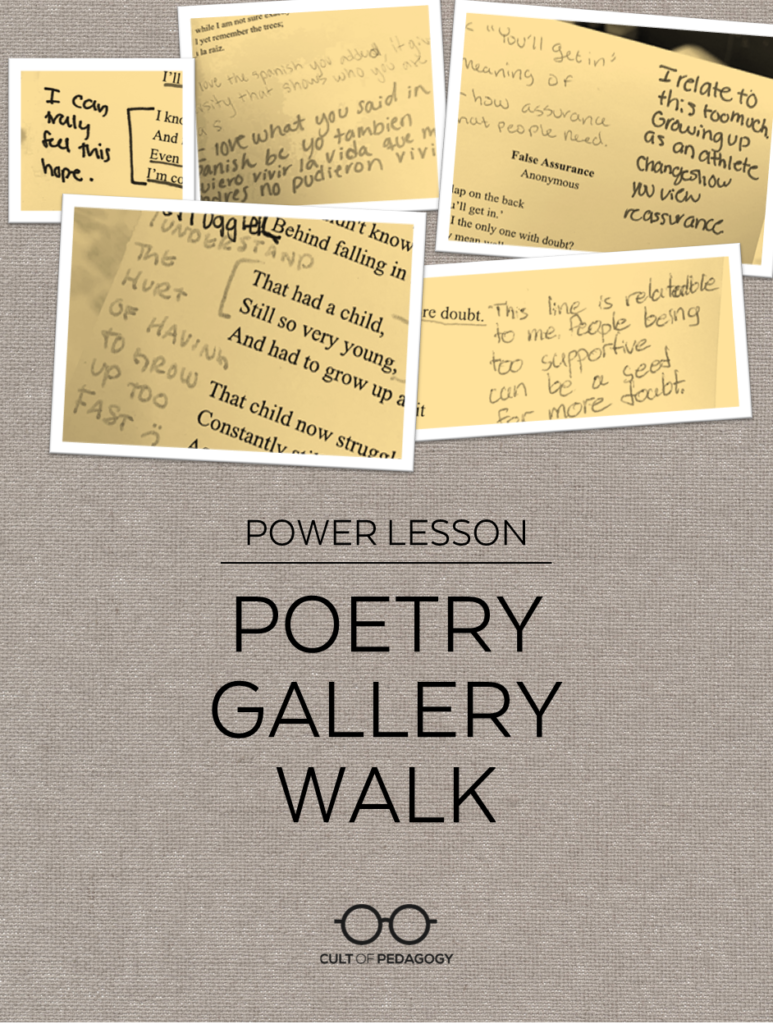
Listen to the interview with Marcus Luther:
Sponsored by Fearless Schools and Read&Write by Texthelp
“Classroom culture” is one of those phrases that is said thousands of times over, often without the “how” and “why.”
Going into the 2021-2022 school year, one of own self-commitments—especially after so much time last year without students in a physical classroom—was to not only honor the value of community in our classroom with my words, but to actually invest time and space within our learning experience to affirm this value. (This is also why the fifth and final core belief of our classroom is built around community: We are each an important part of our community, and our presence and voice matters.)
Without affording time and space, our values come across as rather empty, after all.
So three months into the school year, it was time to “pay the piper” in our AP Literature classroom in a major way. This meant veering away from normal processes of literary analysis and having students not only write their own reflective narrative poems, but spend time in an incredible, silent space moving around the library and writing notes of affirmation on each other’s writing.
Here is “how” we made it happen, then, as well as “why.”
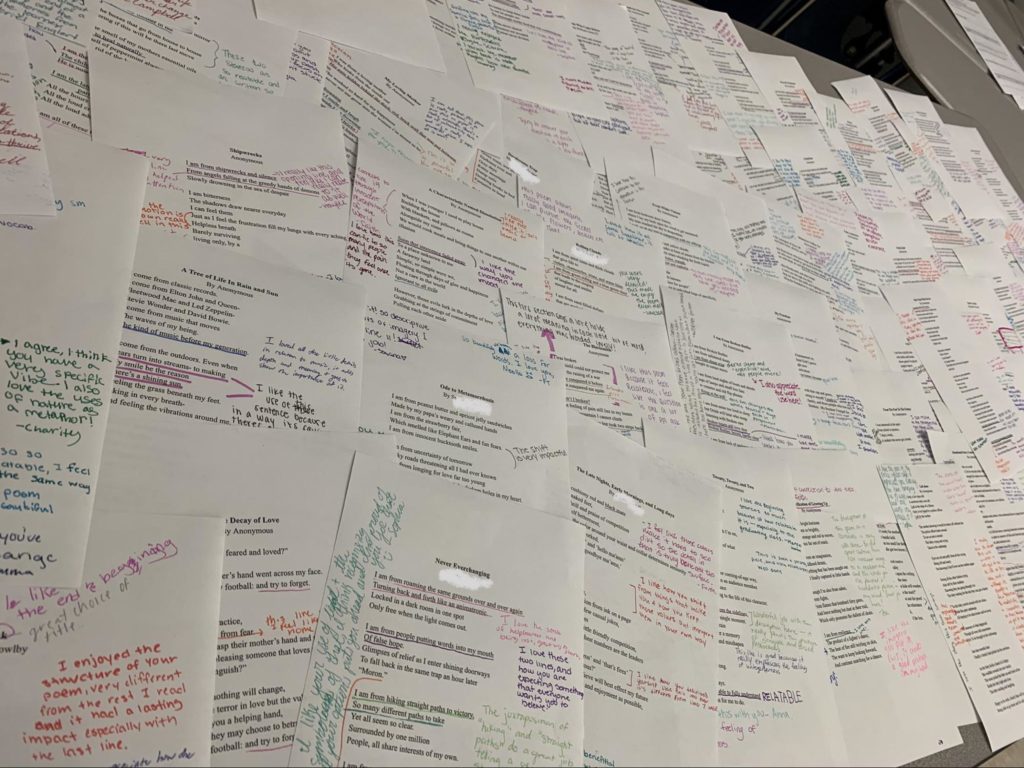
Step 1: The Assignment
The assignment itself was built from the poem Where I’m From by George Ella Lyon—if you’re reading this, you may have used this poem in your own classroom before!—with a few slight modifications.
After some brainstorming around precise imagery, students were provided the exemplar “Where I’m From” poem by Lyon along with this prompt:
Write a 15+ line, 3+ stanza narrative poem that engages with your past (“where I’m from”), your present (“where I am”) and/or your future (“where I will be”) that includes at least three specific examples of imagery/symbolism.
Here are two specific modifications I made to the assignment, knowing that the gallery walk was our ultimate destination:
- Students could request for their poem to be anonymous for the gallery walk. Especially after last year’s distance learning and the heightened stressors and anxieties on the shoulders of students, the last thing I wanted to do was make students feel uncomfortable with the activity. Giving them the option of anonymity as they shared their narrative writing with peers was a crucial step that I highly recommend.
- Adding “Present” and “Future” instead of just “Past.” This is also motivated by giving students freedom to write about what they felt comfortable writing about, and probably more importantly to not write about something they did not want to share. Particularly in an exercise that would end with sharing their writing with peers, this was a way to increase flexibility. It also offered more creativity in terms of chronology and structure, which many utilized in awesome ways.
Finally, what I do with most writing assignments for my classes but always with creative/narrative exercises: I created my own exemplars to share with them. I am a huge advocate of leaning into exemplars to help students grow as writers; I also believe in the reciprocity that takes place as a teacher when sharing my own writing with them first.
Students were given brainstorming time and then had a little over a week to create and submit their final product—all while we were diving into our poetry unit, which offered even more examples through the masterful poetry of Gwendolyn Brooks and Emily Dickinson. (You can never have enough exemplars!) For those curious about what type of results you can end up with, here is a peek at seven of the poems students created.
Step 2: The Teacher Feedback
Here’s the step that I’ve skipped in the past that I added this time before the gallery walk that I highly recommend prioritizing for those embarking towards the final stage of this sequence: offering affirming teacher feedback before the gallery walk.
Yes, this does take time—and I actually used a built-in feature in our school’s online Canvas platform to record a couple minutes of audio feedback for each submission. Do this with nearly 100 poems, and that is no small chunk of time, either.
Why invest this feedback before the gallery walk? Here is my three-part rationale:
- Students entered into this activity all over the place in terms of their own confidence in their writing, so I believe it was critical to help build their own belief in themselves as writers prior to entering the gallery walk space.
- Working backwards from the goal of the gallery walk to be a safe, affirming space, anything that I could do as a teacher to embolden students was about investing in the potential of that space itself.
- Finally, with all narrative writing, I think teachers have a responsibility to look through what students submit before it is shared publicly and/or with peers, as you never know what will turn up in this type of writing!
As one student remarked to me after listening to the audio feedback, “Mr. Luther, I didn’t think what I wrote would get across to anyone, but you got it! So I feel a lot better about what I wrote now.” That shift—to a place of feeling at least somewhat confident in their own writing (which we had already been working on with our Beautiful Language Wall throughout the semester)—was the goal of the feedback prior to the gallery walk.
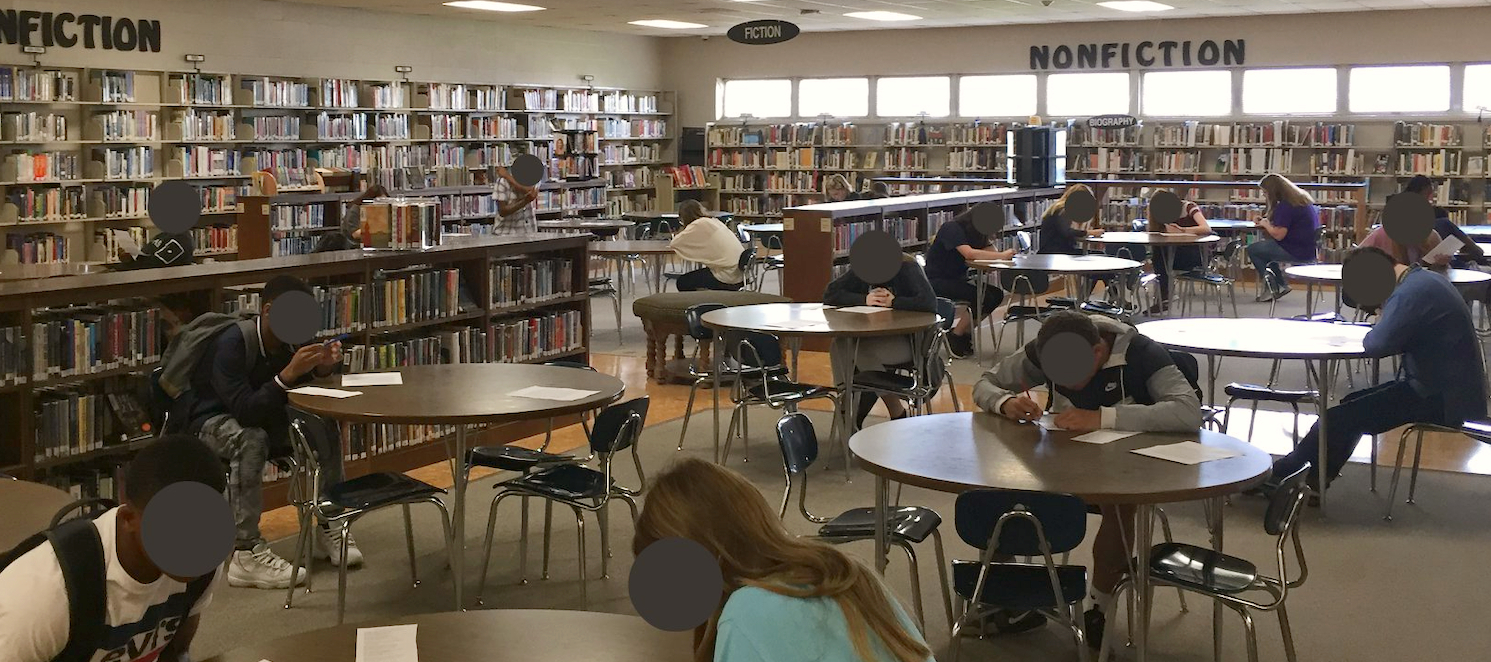
Step 3: Planning and Creating the Gallery Walk Space
I have done this activity at multiple schools, and each time I try to make sure that this takes place outside of the classroom. I usually lean on our school library as the best potential space.
In my eyes, there is a benefit of creating a different atmosphere simply by stepping into a new space. It makes the day feel different for students, and also has the added benefit of stepping into a much larger space that gives students the proximity to be present in their own reflection and affirmation. (And silent, as I’ll discuss in Step 4.)
After reviewing the poems, I physically printed out each of them and made sure to double-check and triple-check which students had requested theirs to be anonymous. I gave our media specialist a heads up about what we would be doing, and she and her team did the rest of the work in making sure the library would be set up for an incredible experience.
(And being relatively new to my current school, I genuinely appreciated the chance to connect with colleagues beyond my classroom—as I have the bad habit, as I’m sure many teachers do, of unintentionally finding myself isolated at times in my own classroom.)
The set-up is flexible to your context, but here are three suggestions I’d offer:
- More space = better. We spread out the poems as much as possible across the library, across empty shelves and tables, to make sure that students could have the space they needed to center themselves in the feedback. (Note: if you are in a classroom, taping them on the walls would be another option to spread them out more!)
- Prevent as many interruptions as possible. This is why I like the library as a setting: it’s a silent space. But even if you do this in your classroom, try to anticipate any potential disruptions. As I’ll discuss in the next section, maintaining silence is an important part of making this the best experience possible.
- Try to get colored pens of various colors. Along with potentially going to a new space, adding in this small step—equipping each student with their own colored pen for the activity—makes it feel different from the get-go, and also has the added benefit of making the collection of different-colored peer affirmations at the end on each paper quite a thing to behold for the students receiving their poems back.
Finally, one choice I made this time was to have students complete this peer gallery walk with the poems from all class periods rather than just their current class period. I made this choice because at our school student schedules shift a lot at semester break, which means that many students move into different AP Literature sections for the second half of the year. For this reason, I wanted students to see and affirm poems from all the classes to begin laying the groundwork for our classroom communities going forward—but for your classes you might find more comfort and value for your students to only share their writing with their own class period.
Step 4: Day-Of Norming and Framing
I cannot overstate this: How you frame the gallery walk will shape this experience.
So here are the four steps that took place the day of the gallery walk this year in our classroom before we headed down to the library for it to take place:
- In our classroom, we regularly center the poem “In Lak’ech” by Luis Valdez through choral reading—connecting to our value of generosity—so we began there, as I asked students to brainstorm a time where they did not receive the affirmation and support they needed and what that felt like (or a time in which they did not offer it to someone else who needed it).
- From there, we shifted to the power of affirmation in our lives and set that as a goal for each of them individually, as students were asked to silently reflect on what it means to make sure another person’s story is not only heard but affirmed—as that was exactly the opportunity we were about to enter into.
- Thirdly, we went over four different ways to affirm each other’s writing: a) highlighting a specific phrase/line that stood out to you; b) offering a connection or a way their poem resonated with you; c) appreciating a manner or style in which the poem was written; or d) naming and reflecting on a value you noticed within the poem itself. I believe that this was another critical step, too, especially for the first class that would be working with blank poems to leave feedback on.
- And finally, we set a norm of silence—how the space would be silent from the moment they entered until the moment they left; how no partnering or discussion would take place; how they would stay present the entire time, which meant no cellphone checks or any other distraction. I offered to them to consider how rare silence really is, too, in our lives, and how often we fend it off automatically with earbuds or airpods: “How often do you all get thirty minutes of silence, really?”
(Note: an additional norm I found helpful to add in by the second class was to not spend any time or energy seeking out your own poem, as that would be taking away from your ability to be generous with your presence and affirmation towards peers.)
Then they each made sure they had a different colored pen from our class utensils bin (and a back-up, just in case!) and we made our way down—and it 100% lived up to everything I could have expected and more:
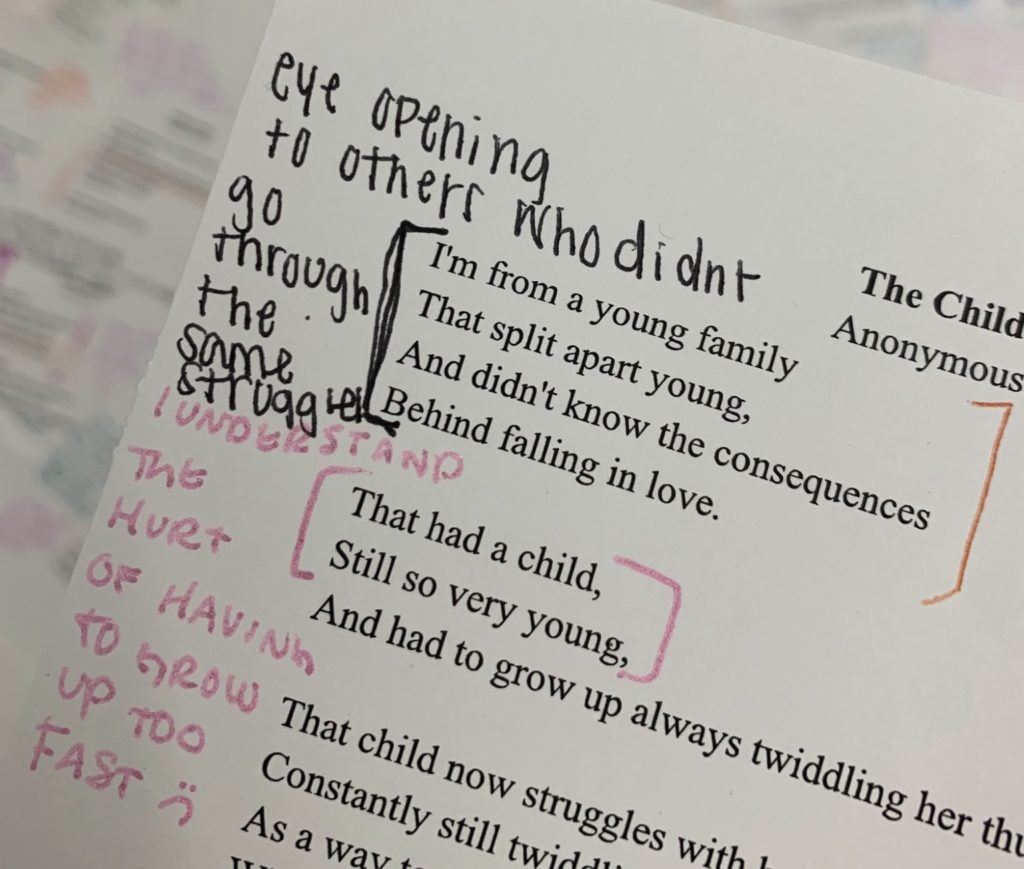
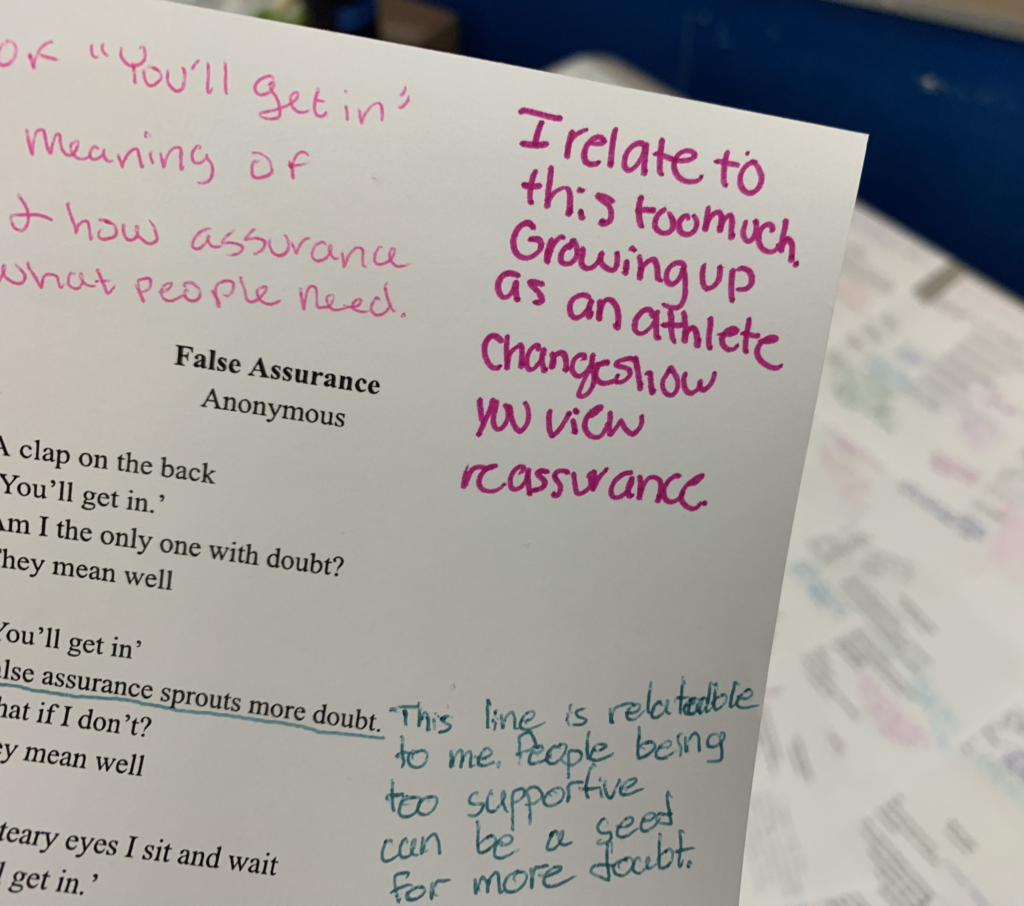
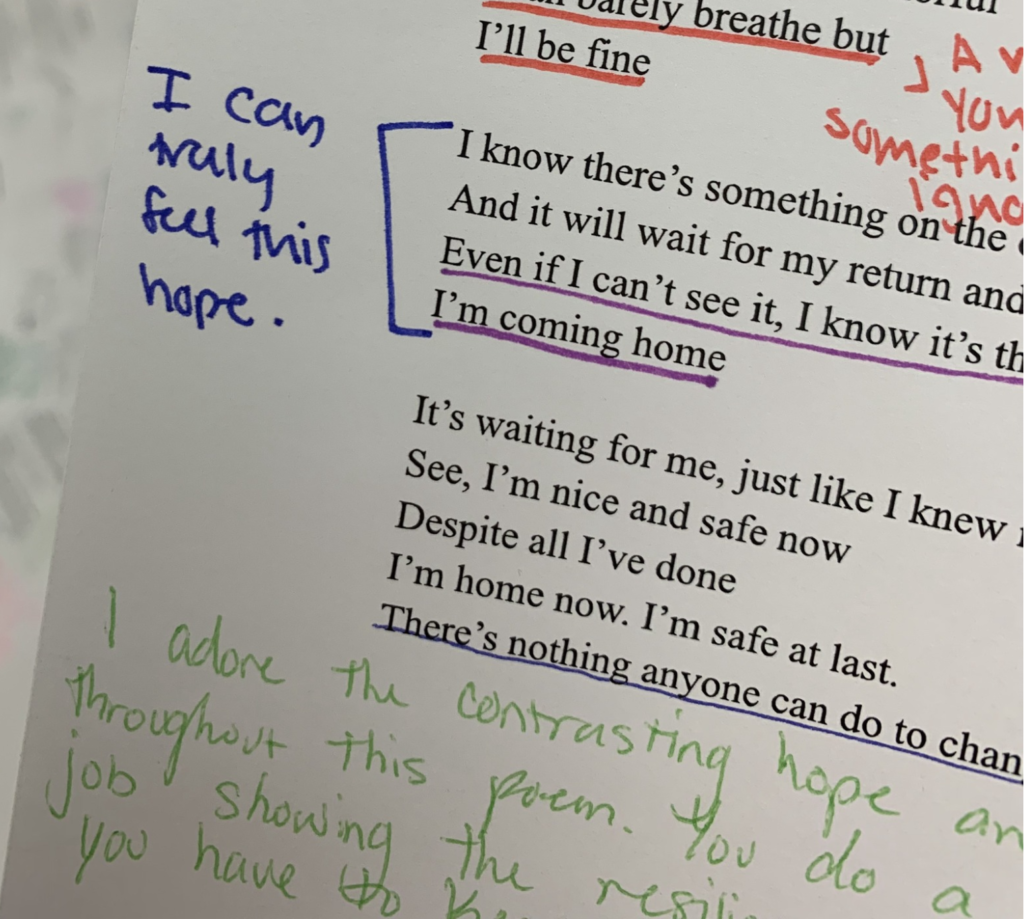
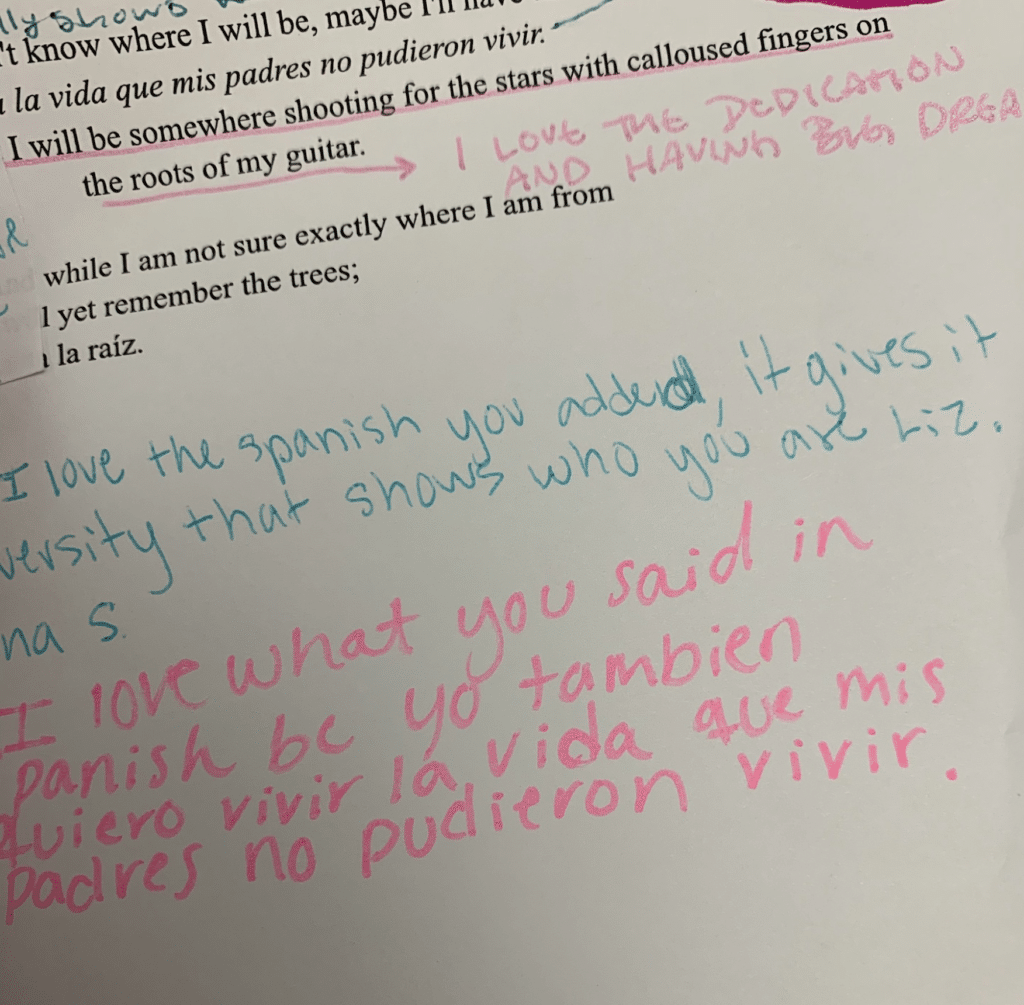
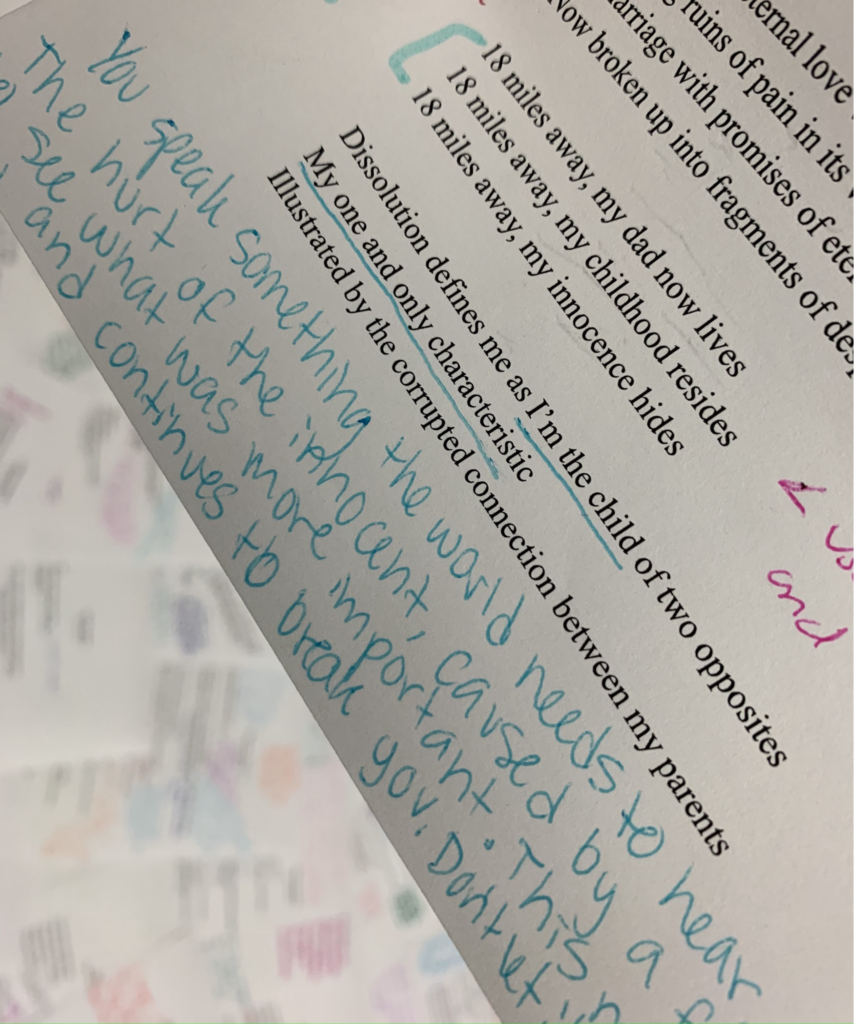
Step 5: Creating Closure
When we returned to the classroom after this activity, we of course took time to debrief—first individually and then collectively. In whole-class remarks, one student noted just how many patterns they saw across the various poems, how often the pasts and futures of the different stories translated into one another. How empathy could walk hand-in-hand with individuality.
And of course this led to the easy pivot to how we opened that lesson, with the first two lines of “In Lak’ech”: Tu eres mi otro yo. / You are my other me.
Once all the gallery walks were done, students were handed back their poems—and you could feel the anxiety as they awaited the comments of their peers, even knowing that these were filled with affirmation. The couple students who were absent when they were passed back immediately asked for theirs when they returned to class, too, demonstrating the urgency that lingered even a week after the activity.
Finally, then, we ended our semester just last week with one final iteration of this activity, weeks after it had taken place: I passed out the following poem, which pulled from myriad of the poems to bring them together into a single collage poem, a demonstration of the synchronicity across their writing one last time.
That collective poem ended with a rhyming couplet, from two different students’ poems fused together:
Simple, so simple were we / I am a shadow only mirrors can see
One final reminder that sometimes we need to see each other to see ourselves.
Some Closing Why Thoughts
So that was the how—but I want to circle back to the why one more time.
I know in my own career, sometimes I notice a chasm growing between the values I present to students and the actual way time is spent in our classroom. There are myriad reasons for that, especially in a year in which “urgency” is being pressured upon teachers to make up for “lost learning” and help get students “back on track.”
Sometimes I notice a chasm growing between the values I present to students and the actual way time is spent in our classroom.
Instead, though, this year I was determined to hold myself accountable to the opportunity that was the physical classroom, something I have found myself treasuring more than ever since having to work in a virtual space for nearly a year.
Prioritizing our values of generosity and community as a classroom meant investing the time to make those priorities a reality.
And that’s really all it takes, too, as we all know how much joy and inspiration students themselves walk into our rooms with daily. It is what makes this work worth it despite everything else, and why the stubbornness of my hope always seems to outlast the omnipresence of outside cynicisms.
As one student wrote upon another’s poem, “I can truly feel this hope.”
What better way to use the classroom space is there, really?
Oh, And a Final Thing!
If you successfully bring this to life in your own classrooms, I’d love to let my students see a glimpse of how their affirmations stretched beyond our own classroom community and into others—feel free to email me at marcus.luther@gmail.com to share any results! (or if you have any questions/clarifications, which I’d be happy to support you with!)
Join our mailing list and get weekly tips, tools, and inspiration that will make your teaching more effective and fun. You’ll get access to our members-only library of free downloads, including 20 Ways to Cut Your Grading Time in Half, the e-booklet that has helped thousands of teachers save time on grading. Over 50,000 teachers have already joined—come on in.


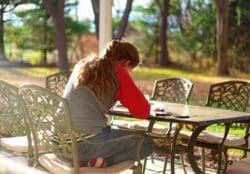
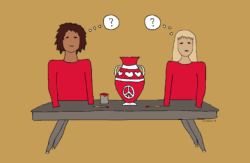
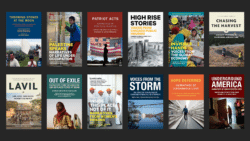
This is incredibly inspiring to my on many levels. After seeing various popular SEL curricula (trite and fluffy!), the emotional/relational depth offered here is mind-blowing . I can only imagine the amount of connection already happening in this room, and how the community would grow from this experience. Wow.
You created a beautiful experience for your students, and for me reading about it! Thank you so much!
So glad you liked this, Jessica! I’ll be sure to let Jenn know!
Hi Marcus,
I think this is a really beautiful activity you have developed and I look forward to implementing something similar in my own classes! I don’t teach English but I am already thinking of different ways I can incorporate this affirmation process into Social Studies.
The way your students were impacted by the process really demonstrates the importance of a humanistic approach to teaching. Learning is relevant, provokes feeling, and allows students to experience success. This activity focuses on growth and really educating the whole child.
My question for you is how do you keep this momentum going? I have had powerful lessons and presentations with my class but it is so hard to keep that mentality fresh in their minds. Do you have any tips for this?
Thanks!
That’s a great question, Tai. Marcus alludes to two things in the introduction of the post that I think might play a factor in sustaining the momentum that he built with students during this power lesson. First, he talks about the importance of investing the time and space in learning experiences to affirm the value of community. Secondly, he links the five core beliefs of his classroom, which appear to be displayed prominently and are likely referenced throughout the year. Marcus has also provided his contact information at the end of the post. If you try a variation of this lesson, I’m sure he would love to hear about it!